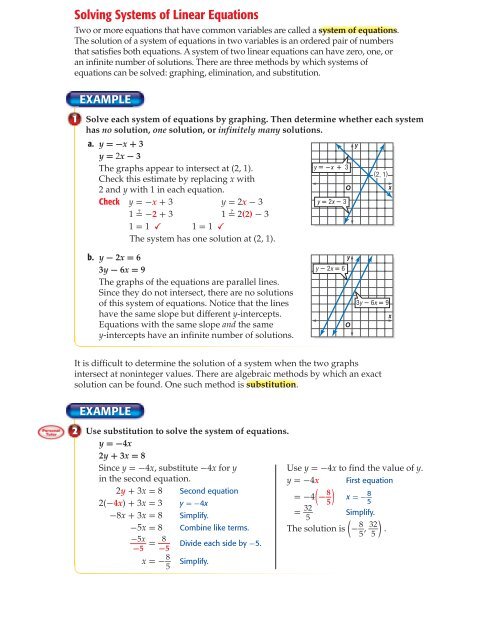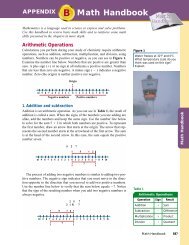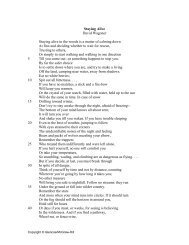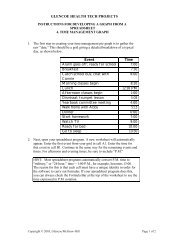Solving Systems of Linear Equations - Glencoe
Solving Systems of Linear Equations - Glencoe
Solving Systems of Linear Equations - Glencoe
You also want an ePaper? Increase the reach of your titles
YUMPU automatically turns print PDFs into web optimized ePapers that Google loves.
<strong>Solving</strong> <strong>Systems</strong> <strong>of</strong> <strong>Linear</strong> <strong>Equations</strong><br />
Two or more equations that have common variables are called a system <strong>of</strong> equations.<br />
The solution <strong>of</strong> a system <strong>of</strong> equations in two variables is an ordered pair <strong>of</strong> numbers<br />
that satisfies both equations. A system <strong>of</strong> two linear equations can have zero, one, or<br />
an infinite number <strong>of</strong> solutions. There are three methods by which systems <strong>of</strong><br />
equations can be solved: graphing, elimination, and substitution.<br />
EXAMPLE<br />
1 Solve each system <strong>of</strong> equations by graphing. Then determine whether each system<br />
has no solution, one solution, or infinitely many solutions.<br />
a. y = -x + 3<br />
y = 2x - 3<br />
y<br />
The graphs appear to intersect at (2, 1).<br />
Check this estimate by replacing x with<br />
y x 3<br />
2 and y with 1 in each equation.<br />
O<br />
Check y = -x + 3 y = 2x - 3<br />
y 2x 3<br />
1 -2 + 3 1 2(2) - 3<br />
1 = 1 1 = 1<br />
The system has one solution at (2, 1).<br />
b. y - 2x = 6 y<br />
3y - 6x = 9<br />
The graphs <strong>of</strong> the equations are parallel lines.<br />
Since they do not intersect, there are no solutions<br />
<strong>of</strong> this system <strong>of</strong> equations. Notice that the lines<br />
have the same slope but different y-intercepts.<br />
y 2x 6<br />
<strong>Equations</strong> with the same slope and the same<br />
y-intercepts have an infinite number <strong>of</strong> solutions.<br />
O<br />
(2, 1)<br />
3y 6x 9<br />
It is difficult to determine the solution <strong>of</strong> a system when the two graphs<br />
intersect at noninteger values. There are algebraic methods by which an exact<br />
solution can be found. One such method is substitution.<br />
EXAMPLE<br />
2 Use substitution to solve the system <strong>of</strong> equations.<br />
y = -4x<br />
2y + 3x = 8<br />
Since y = -4x, substitute -4x for y<br />
in the second equation.<br />
2y + 3x = 8 Second equation<br />
2(-4x) + 3x = 3 y = -4x<br />
-8x + 3x = 8 Simplify.<br />
-5x = 8 Combine like terms.<br />
_-5x =<br />
-5<br />
8_ -5<br />
x = - 8_ 5<br />
Divide each side by -5.<br />
Simplify.<br />
Use y = -4x to find the value <strong>of</strong> y.<br />
y = -4x First equation<br />
= -4( - 8_ x = - 5) 8_ 5<br />
=<br />
32 _ Simplify.<br />
5<br />
The solution is (- 8_ ,<br />
5<br />
32_<br />
5 ) .<br />
x<br />
x
Sometimes adding or subtracting two equations together will eliminate one<br />
variable. Using this step to solve a system <strong>of</strong> equations is called elimination.<br />
EXAMPLE<br />
3 Use elimination to solve the system <strong>of</strong> equations.<br />
3x + 5y = 7<br />
4x + 2y = 0<br />
Either x or y can be eliminated. In this example, we will eliminate x.<br />
3x + 5y = 7 Multiply by 4. 12x + 20y = 28<br />
4x + 2y = 0 Multiply by -3. + (-12x) - 6y = 0<br />
14y = 28<br />
_14y =<br />
14<br />
Add the equations.<br />
28 _ 14<br />
Divide each side by 14.<br />
y = 2 Simplify.<br />
Now substitute 2 for y in either equation to find the value <strong>of</strong> x.<br />
4x + 2y = 0 Second equation<br />
4x + 2(2) = 0 y = 2<br />
4x + 4 = 0 Simplify.<br />
4x + 4 - 4 = 0 - 4 Subtract 4 from each side.<br />
4x = -4 Simplify.<br />
4x_ 4 =<br />
-4 _ 4<br />
x = -1<br />
Divide each side by 4.<br />
Simplify.<br />
The solution is (-1, 2).

















